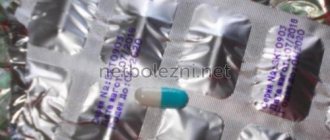Exhausting allergies, chronic sinusitis, polyps in the nasal cavity... It’s not a pleasant set. But even with it one can and must fight. Most often, the attending physician prescribes Nasonex spray. The drug has anti-inflammatory and antiallergic effects. It is based on mometasone furoate, which belongs to the group of glucocorticoids and is considered a synthetic drug.
an analogue of adrenal hormones, corticosteroids (GCS) for topical use.
Nasonex copes well with allergic rhinitis
Mometasone suppresses inflammatory and allergic reactions of various types when used in doses at which systemic effects do not develop. The therapeutic effect is observed 12 hours after the start of use.
Despite the fact that Nasonex is a hormonal drug, it does not affect other organs and systems except the nose.
A small dosage and use only in the nasal area ensures a very low concentration of mometasone in the blood. Also, it is worth noting that Nasonex is not addictive.
Pharmacodynamics and pharmacokinetics
The active ingredient is beclomethasone . The aerosol is effectively used in the treatment of bronchial asthma (basic therapy).
Aldecine has antiallergic and moderate anti-inflammatory effects. Beclomethasone enhances the production of the A2 phospholipase inhibitor - annexin (lipocortin), inhibits the production of inflammatory mediators, reduces the release of arachidonic acid , and has an inhibitory effect on the synthesis of arachidonic acid metabolic products - prostaglandins and endoperoxides.
The anti-inflammatory effect is due to inhibition of the formation of chemotaxis , the formation of a slow allergic reaction slows down.
Belomethasone improves mucociliary transport , reduces the number of mast cells in the bronchial mucosa, reduces bronchial hyperreactivity, and reduces the secretion of mucus produced by the bronchial glands.
Aldecine has a positive effect on functional indicators of external respiration. The drug allows you to restore the patient's response to the effects of bronchodilators, which significantly reduces the frequency of their use.
The drug increases the number of active beta-adrenergic receptors and does not have a resorptive effect when used in inhalation.
The use of the drug Aldecin in therapeutic doses does not lead to the development of systemic side effects that occur when using glucocorticosteroids. The therapeutic effect develops gradually; the drug does not relieve bronchospasm .
Aldecin
Before prescribing inhaled drugs, it is necessary to instruct the patient about the rules for using the drug to ensure the most complete delivery of the drug to the desired areas of the lungs.
The drug is not intended for the relief of acute asthmatic attacks. Patients should be aware of the preventive nature of the drug and that to achieve optimal effect, the inhaler should be used regularly, even in the absence of asthma symptoms.
With regular inhalation of beclomethasone, improvement in breathing usually occurs after 1 week of treatment. Lack of effect is possible in patients with increased levels of sputum and mucus in the respiratory tract and severe bronchospasm, which prevents the drug from reaching the zone of action. In such cases, inhalation of adrenergic stimulants is prescribed 15-30 minutes before inhalation of beclomethasone or treatment is started with the systemic use of GCS.
The transfer of patients regularly taking oral corticosteroids to inhaled beclomethasone, as well as subsequent treatment, should be carried out with extreme caution, under daily monitoring of peak flowmetry (pneumotachometry), since suppression of the adrenal cortex caused by long-term use of corticosteroids is restored slowly.
Before prescribing inhaled forms of beclomethasone, patients should be in a relatively stable condition, and their prescription itself should complement the usual maintenance dose of systemic corticosteroids. After about 1 week, the daily dose of steroids begins to be gradually reduced - 1 mg/week (in terms of prednisolone). Deterioration of the condition against the background of a maintenance dose of 400 mcg/day means the need to transfer patients to oral prednisolone. Regular use allows in most cases to cancel oral corticosteroids (patients who need to take no more than 15 mg of prednisolone can be completely transferred to inhalation therapy), while in the first months after the transition the patient’s condition should be carefully monitored until his pituitary-adrenal system recover sufficiently to respond to stressful situations (such as injury, surgery, or infection).
Patients transferred to inhalation treatment and having impaired function of the adrenal cortex should have a supply of GCS and with them a warning card, which should indicate that in stressful situations they need additional systemic administration of GCS (after eliminating the stressful situation, the dose of steroids can be repeated reduce). Sometimes a transfer from taking systemic corticosteroids to inhalation administration can lead to the manifestation of previously suppressed forms of allergies, such as allergic rhinitis or eczema.
It is necessary to protect the eyes from contact with the drug.
It is advisable to rinse the mouth and throat after inhalation (prevention of candidiasis), and when initial signs of fungal infection of the oral mucosa appear, use nystatin, fluconazole, amphotericin. By washing after inhalation you can prevent damage to the skin of the eyelids and nose.
The maximum daily dose of the drug in adults should not exceed 1 mg. At a dose of up to 1.5 mg/day in most patients, it does not significantly suppress adrenal function. If this dose is exceeded, some patients may experience some suppression of adrenal function. Treatment in doses of more than 1 mg/day is carried out under the supervision of a physician.
During pregnancy and breastfeeding, beclomethasone should be used with caution and only when the benefits of its use outweigh the potential risks. There is insufficient data on the safety of beclomethasone dipropionate in pregnant women and on its excretion in women's breast milk.
Beclomethasone preparations, containing 50-100 mcg in 1 dose, play an important role in the treatment of severe forms of bronchial asthma in children, since they provide good control over the course of the disease and do not cause growth retardation in the child. Beclomethasone 250 mcg is not intended for use in pediatrics. It is recommended to regularly monitor the growth dynamics of children receiving inhaled corticosteroids over a long period of time.
Infectious and inflammatory diseases of the respiratory system are not a specific contraindication for treatment with beclomethasone.
The drug should not be frozen or exposed to direct sunlight. The bottle of the drug must not be pierced, disassembled or thrown into fire, even if it is empty. When the canister cools, it is recommended to remove it from the plastic case and warm it with your hands (at low temperatures, the effectiveness of the drug is reduced).
Contraindications
Aldecine is contraindicated in non-asthmatic bronchitis, acute bronchospasm, beclomethasone intolerance, and status asthmaticus.
Contraindications also include: tuberculosis, nosebleeds, age under 6 years.
For glaucoma , liver cirrhosis, breastfeeding , osteoporosis , hypothyroidism , pregnancy , systemic diseases (viral, parasitic, fungal, bacterial infections) prescribe with caution.
Nasonex during pregnancy
Due to the fact that there are no clinically proven studies of the effect of the active substance - mometasone furoate - on the body of a pregnant woman, the fetus and during lactation, the drug is prescribed with caution starting from the second trimester, and only when the expected effect of therapy justifies the potential risk to the fetus/newborn .
Nasonex during pregnancy
When using the drug during pregnancy, newborns should be carefully monitored for adrenal hypofunction.
Side effects
Irritation in the throat, hoarseness, sneezing , cough, paradoxical bronchospasm , oral candidiasis, allergies, eosinophilic pneumonia .
With long-term use of the drug in increased quantities, systemic side effects develop, adrenal insufficiency , leukocytosis, increased intraocular pressure, dizziness, headaches, eosinopenia, cataracts , lymphopenia.
With a single dose of high doses of Aldecin, a decrease in the function of the hypothalamic-pituitary and adrenal systems is recorded.
The systems are restored on their own after 2 days.
Guidelines for patients on inhalation with Aldecin spray
Before using a new bottle of the drug, you should calibrate it, that is, press the dosing device 6-7 times. After this, the stereotypical supply of the drug will be established. If the cylinder has not been used for more than 14 days, it must be recalibrated before use.
Before using Aldecin nasally, it is necessary that the nasal passages are clear. The nasal applicator is inserted in a vertical position towards the inner corner of the eye. The second nostril should be pressed with a finger, and the head should be tilted forward.
Pressing the Aldecin spray should occur while inhaling and exhaling through the mouth. Spraying the spray directly onto the nasal septum is unacceptable!
Instructions for use of Aldecin (Method and dosage)
Aerosol
Used by inhalation.
For adults:
- Mild bronchial asthma: 100 mcg 3 times a day.
- For severe bronchial asthma, 200 mcg is prescribed 3 times a day. The maximum daily dose is 1 mg.
Children from 6 to 12 years old can use a maximum of 0.5 mg per day.
Upon completion of inhalation, it is recommended to rinse the mouth with running water.
Aldecin spray, instructions for use
From the age of six, you can use one or two injections in each nostril twice a day.
Indications
The main indications for the use of Nasonex spray are:
- allergic rhinitis (seasonal or year-round), which is accompanied by constant rhinorrhea and swelling of the nasal mucosa;
- exacerbation of chronic sinusitis (the drug is prescribed as an adjunct to antibiotic therapy) in adolescents and adults;
- polyps of the nasal cavity, which lead to disruption of full respiratory function.
Children are prescribed Nasonex allergy spray from the age of two. For the treatment of sinusitis in pediatrics, it is used in children over twelve years of age.
Nasonex drops can be taken by children from 2 years of age
Also, the spray is used to prevent moderate/severe seasonal allergic rhinitis. Nasonex must be used 2 weeks before the expected start of the dusting period.
Interaction
Aldecine allows you to restore the patient's response to the use of beta-agonists , which significantly reduces the frequency of their use.
There are no significant drug interactions between inhaled glucocorticosteroids and other medications.
Inducers of microsomal oxidation ( rifampicin , phenobarbital, phenytoin) reduce the effectiveness of beclomethasone.
Estrogens, methandrostenolone , theophylline, beta2-adrenergic stimulants enhance the effect of the drug Aldecin.
special instructions
Aldecine is not used to relieve acute attacks of bronchial asthma. Patients must be explained that the drug has a preventive effect, and that to achieve maximum effect, the drug must be used regularly, including in the absence of signs of asthma.
Regular use of the inhaler can improve respiratory function after just a week of treatment. The reason for the lack of effect may be the increased content of mucus and sputum in the respiratory system, as well as as a result of severe bronchospasm, which prevents beclomethasone from penetrating into the area of action.
Before prescribing Aldecin, the doctor must instruct the patient about the aspects of proper use of the inhaler, which will subsequently provide a better therapeutic effect due to the complete penetration of the main substance into the lungs.
When transferring a patient from an oral glucocorticosteroid to Aldecin, regular peak flow measurements .
Washing after using the drug helps prevent damage to the nose and eyelid skin.
Nasonex for adenoids
Enlarged adenoids are a fairly common complication of allergic rhinitis. Nasonex relieves swelling and often prevents the need for surgery.
A similar effect is achieved by suppressing lymphoid tissue. But it should be borne in mind that in case of severe inflammation, Nasonex is ineffective. Also, the hormonal nature of the drug suppresses the immune system to some extent, so after discontinuation of the drug, inflammation in the adenoids may resume (especially in children). To relieve this condition, it is recommended to undergo a course of anti-inflammatory treatment of adenoid vegetations. And also strengthen your immune system, eat right, walk in the fresh air, play sports and have as little contact with household chemicals and dust as possible.
Aldecin's analogs
Level 4 ATX code matches:
Alvesco
Budenit Steri-Neb
Asmanex
Beclazon
Budesonide
Flixotide
Pulmicort
Analogs include the following drugs: Beclazon , Beclat , Glenbekar , Klenil .
Composition, release form and analogues
1 dose of Aldecin contains 50 mcg of beclomethasone dipropionate as an active ingredient and the following auxiliary components:
- Dispersed cellulose;
- Propylene glycol;
- Sodium citrate dihydrate;
- Glycerol;
- Polysorbate 80;
- Citric acid monohydrate;
- Purified water.
Aldecin spray is available in the form of aerosol cans with a metering valve, a nasal applicator and a special mouthpiece. One bottle contains 8.5 g of the drug, which is equivalent to 200 doses. One cardboard package contains 1 aerosol can.
Among Adeltsin's analogues, the following drugs can be distinguished:
- Beclazon;
- Beclazon Eco;
- Beclazon Easy Breathing;
- Beclazon Eco Easy Breathing;
- Beclomethasone;
- Beclomethasone dipropionate;
- Beclomethasone Orion Pharma;
- Beklomet Easyhaler;
- Beclospira;
- Becotide;
- Rinoclenil;
- Klenil;
- Klenil UDV;
- Plibekot;
- Nasobek.


